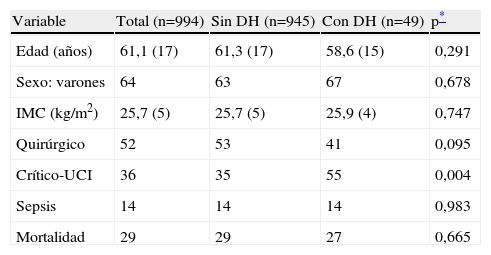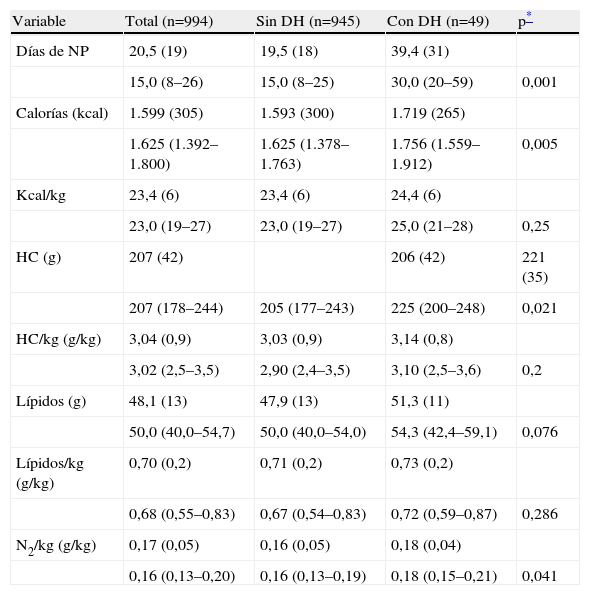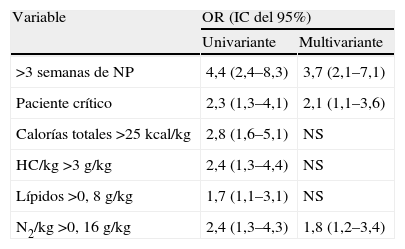el objetivo de este trabajo es describir la incidencia de disfunción hepática (DH) en nuestro hospital y evaluar los posibles factores de riesgo asociados al desarrollo de DH como mejora del proceso asistencial de los pacientes con nutrición parenteral (NP).
Pacientes y métodose ha realizado un estudio prospectivo de los pacientes (n=994) que requirieron NP durante el período 2000–2004. Se definió la DH como un aumento mayor de 1,5 veces el valor superior de referencia de la fosfatasa alcalina (40–450U/l) y la gammaglutamil transpeptidasa (11–49U/l), asociado a un aumento de las transaminasas (5–31U/l) y de la bilirrubina total superior a 1,2mg/dl.
Resultadosla incidencia de DH fue del 4,9% (n=49). Los días de NP fueron significativamente mayores en el grupo de DH, con una mediana (intervalo intercuartílico) de 30 (20–59) frente a 15 (8–25) días (p<0,001). En el análisis univariado las variables que alcanzaron una odds ratio significativa fueron el estado de paciente crítico, la duración de la NP, el aporte de calorías superior a 25kcal/kg, superar los 3g de aporte de hidratos de carbono por kilogramo, administrar más de 0,8g/kg de lípidos y superar los 0,16g de nitrógeno por kilogramo. El modelo multivariante sólo seleccionó como factores de riesgo independientes: superar las 3 semanas de NP, ser un paciente crítico y un aporte mayor de 0,16g de nitrógeno por kilogramo.
Conclusionesel perfil actual de los pacientes que desarrollarán DH crítico con NP prolongada, en el que hay que controlar no sólo el aporte de calorías, hidratos de carbono o lípidos, sino también el de proteínas.
The objective of this study is to describe the incidence of hepatic dysfunction (HD) in our hospital and evaluate the possible risk factors associated with HD development as an improvement of the caring process received by patients treated with parenteral nutrition (PN).
Patients and methodA prospective study of patients (n=994) who required PN during the period 2000–2004. HD is the identification of an increase above 1,5 of the top reference value of alkaline phosphatase (40–450U/l) and gamma glutamyl transpeptidase (11–49U/l) associated with an increase of transaminases (5–32U/l) and a total bilirrubin higher than 1,2mg/dl.
ResultsThe incidence of HD was 4,9% (n=49). Days with PN were significantly higher in the HD group: median (interquartile range): 30 (20–59) vs 15 (8–25) days (p<0.001). In the univariated HD analysis, the variables that reached significant odds ratio were: the critical patient condition, the PN duration, the total calorie contribution higher than 25kcal/kg, to exceed 3g of carbohydrates/kg, to administer more than 0.8g/kg of lipids and to exceed 0.16g of nitrogen/kg. In the multivariated analysis, the variables selected as independent risk factors were: to exceed 3 weeks of PN, to be a critical patient and a contribution over 0.16g of nitrogen/kg.
ConclusionsThe present profiles of the patients who will develop HD are those with prolonged PN. These patients undergo processes and critical therapy, where the specialists must monitor, not only calorie contribution, carbohydrates or lipids, but proteins as well.
Artículo
Comprando el artículo el PDF del mismo podrá ser descargado
Precio 19,34 €
Comprar ahora









